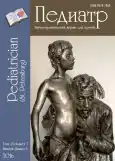Pancreatic type dysfunction of oddi sphincter in children
- 作者: Privorotsky V.F1, Luppova N.E1
-
隶属关系:
- St Petersburg State Pediatric Medical University
- 期: 卷 7, 编号 3 (2016)
- 页面: 111-116
- 栏目: Articles
- URL: https://journals.eco-vector.com/pediatr/article/view/5732
- DOI: https://doi.org/10.17816/PED73111-116
- ID: 5732
如何引用文章
详细
Anatomical and functional characteristics of the pancreas and its close relationship to adjacent organs, primarily duodenum and biliary tract, cause its frequent involvement in pathological process. Difficulties in differentiation of functional and organic pathology of the pancreas are associated not only with the difficulties of diagnostic of functional diseases, but also with the problems of classification and definitions. As to realities of today optimal version is one proposed by the authors of ICD 10 and found further development in the materials of the Rome III consensus - namely the Oddi sphincter dysfunction in pancreatic type. Under this diagnosis there is the possibility for logical explanation of involvement of pancreas in pathological process. The article also describes the diagnostic criteria for the Oddi sphincter dysfunction in pancreatic type, which includes clinical, laboratory and instrumental signs. It is noted that the recommended set of instrumental examination in modern pediatric practice is not only unimplementable, but just is not necessary. The usefulness of the recommended methods (including procedures that are potentially dangerous in terms of developing pancreatitis) for functional disorders is discussing. In the article the issues of nutrition of children with diseases of the pancreas, as well as the program of medical correction of dysfunction of the sphincter of Oddi in pancreatic type, are described.
全文:
作者简介
Valery Privorotsky
St Petersburg State Pediatric Medical University
编辑信件的主要联系方式.
Email: privorotsky@mail.ru
MD, PhD, Dr Med Sci, Professor. Department of Gastroenterology, Faculty of Postgraduate Education 俄罗斯联邦
Natal’ya Luppova
St Petersburg State Pediatric Medical University
Email: nlupp@mail.ru
MD, PhD, Associate Professor. Department of Pediatrics, Endocrinology and Abilitologii AF and DPO 俄罗斯联邦
参考
- Бельмер С.В., Разумовский А.Ю., Корниенко Е.А., Приворотский В.Ф. Болезни поджелудочной железы у детей. — М.: Медпрактика-М, 2015. [Bel’mer SV, Razumovskiy AY, Kornienko EA, Privorotskiy VF. Bolezni podzheludochnoy zhelezy u detey. Moscow: Medpraktika-M; 2015. (In Russ).]
- Бокова Т.А. Метаболический синдром и морфофункциональное состояние поджелудочной железы у детей: клинико-патогенетические взаимосвязи // Педиатр. — 2013. — Т. 4. — № 3. — С. 36–40. [Bokova TA. Metabolic syndrome and morphofunctional state of pancreas in children: clinical and pathogenetic relationship. Pediatr (St Petersburg). 2013;4(3):36-40. (In Russ).]
- Гасилина Т.В., Бельмер С.В. Болезни поджелудочной железы у детей. Первичная и вторичная экзокринная панкреатическая недостаточность // Лечащий врач. — 2010. — № 1. — С. 6–10. [Gasilina TV, Bel’mer SV. Bolezni podzheludochnoy zhelezy u detey. Pervichnaya i vtorichnaya ekzokrinnaya pankreaticheskaya nedostatochnost’. Lechashchiy vrach. 2010;(1):6-10. (In Russ).]
- Губергриц Н.Б. Возможности лабораторной диагностики заболеваний поджелудочной железы // Экспериментальная и клиническая гастроэнтерология. — 2008. — № 7. — С. 93–101. [Gubergrits NB. Vozmozhnosti laboratornoy diagnostiki zabolevaniy podzheludochnoy zhelezy. Eksperimental’naya i klinicheskaya gastroenterologiya. 2008;7:93-101. (In Russ).]
- Гурова М.М., Циркунова В.В. Сопутствующие заболевания органов пищеварения у детей подросткового возраста с хроническим гастродуоденитом // Вестник новгородского государственного университета. — 2014. — № 78. — С. 37–43. [Gurova MM, Tsirkunova VV. Concomitant diseases of the digestive system in teenagers with chronic gastroduodenitis. Vestnik novgorodskogo gosudarstvennogo universiteta. 2014;(78):37-43. (In Russ).]
- Запруднов А.М. Современные клинико-диагностические аспекты детской гастроэнтерологии // Российский вестник перинатологии и педиатрии. — 2010. — № 3. — С. 4–13. [Zaprudnov AM. Sovremennye kliniko-diagnosticheskie aspekty detskoy gastroenterologii. Rossiyskiy vestnik perinatologii i pediatrii. 2010;(3):4-13. (In Russ).]
- Немцов Л.М. Фармакотерапия функциональных расстройств билиарного тракта // Вестник фармации. — 2014. — Т. 66. — № 4 — С. 86–100. [Nemtsov LM. The biliary tract functional disorders pharmacotherapy. 2014; 66(4):86-100. (In Russ).]
- Осадчук М.А., Осадчук А.М., Николенко С.Н. Функциональные расстройства желудочно-кишечного тракта в контексте морфофункционального единства // Клиническая медицина. — 2014. — № 7. — С. 29–31. [Osadchuk MA, Osadchuk AM, Nikolenko SN. Gastrointestinal tract functional disorders in context of morphofunctional unity. Klinicheskaya meditsina. 2014;(7):29-31. (In Russ).]
- Полещук Л.А. Панкреатиты у детей: современные аспекты этиологии, патогенеза и диагностики // Российский вестник перинатологии и педиатрии. — 2010. — № 4. — С. 58–64. [Poleshchuk LA. Pankreatity u detey: sovremennye aspekty etiologii, patogeneza i diagnostiki. Rossiyskiy vestnik perinatologii i pediatrii. 2010;(4):58-64. (In Russ).]
- Приворотский В.Ф., Луппова Н.Е., Румянцева И.В. Заболевания билиарного тракта у детей (этиология, патогенез, клиническая картина, диагностика, лечение): Учебное пособие. — СПб.: Изд. дом СПбМАПО, 2011. [Privorotskiy VF, Luppova NE, Rumyantseva IV. Zabolevaniya biliarnogo trakta u detey (etiologiya, patogenez, klinicheskaya kartina, diagnostika, lechenie). Uchebnoe posobie. Saint Petersburg: Izd. dom SPbMAPO; 2011. (In Russ).]
- Римарчук Г.В., Тюрина Т.К., Васечкина Л.А. Диагностика и лечение хронического панкретатита у детей // Экспериментальная и клиническая гастроэнтерология. — 2010. — № 8. — С. 92–97. [Rimarchuk GV, Tyurina TK, Vasechkina LA. Diagnostika i lechenie khronicheskogo pankretatita u detey. Eksperimental’naya i klinicheskaya gastroenterologiya. 2010;(8):92-97. (In Russ).]
- Рылова Н.В. Диагностика заболеваний поджелудочной железы у детей // Практическая медицина. — 2010. — Т. 42. — № 3. — С. 120–124. [Rylova NV. Diagnostika zabolevaniy podzheludochnoy zhelezy u detey. Prakticheskaya meditsina. 2010;42(3):120-124. (In Russ).]
- Allescher HD. Sphincter of Oddi dyskinesia. Der Internist. 2015;56(6):638-47. doi: 10.1007/s00108-014-3605-8.
- Kutsumi H, Nobutani K, Kakuyama S, et al. Sphincter of Oddi disorder: what is the clinical issue? Clin J Gastroenterol. 2011;4(6):364-70. doi: 10.1007/s12328-011-0260-7.
- Wyllie R, Hyams J, Kay M. Pediatric Gastrointestinal and Liver Disease (4th Edition). New York: Elsevier Saunders; 2011.
补充文件






